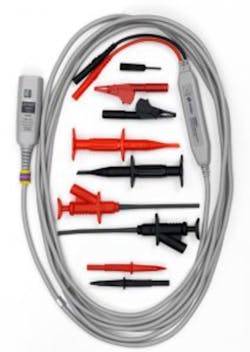Keysight Technologies Inc. has introduced 200-, 300-, and 500-MHz high-voltage probes with a wider input range, higher common-mode rejection ratio, and optimized accessories. The probes are suitable for testing today’s switching power supplies or power devices and for measuring motor drives and vehicle buses.
The Keysight N2804A differential probe offers up to 300-MHz bandwidth and ±300-VDC + peak AC of the maximum differential input range, allowing engineers to use it for a broad range of power applications. The N2805A 200-MHz differential probe comes with a 5-m input cable, which allows engineers to easily reach DUTs over long distances.
The probes have a differential input resistance of 4 MΩ and low input capacitance of 4 pF to minimize circuit loading. The N2804A and N2805A probes are compatible with Keysight oscilloscopes with a 50-Ω AutoProbe interface, which automatically configures the scope for the probe.
The Keysight 10076C 100:1 passive probe with 66.7-MΩ input resistance provides the voltage and bandwidth engineers need for making high-voltage measurements referenced to the ground with low input loading. The probe provides 500-MHz bandwidth when used in conjunction with a spring ground tip to reduce inductive ground loading.
The Keysight N2804A and N2805A differential probes are available now at a price of $2,300 and $2,500 respectively. The 10076C passive probe is available now and is priced at $450.
Information about the Keysight N2804A and N2805A differential probes is available at www.keysight.com/find/differential. Information about the Keysight 10076C passive probe is available at www.keysight.com/find/10076C


